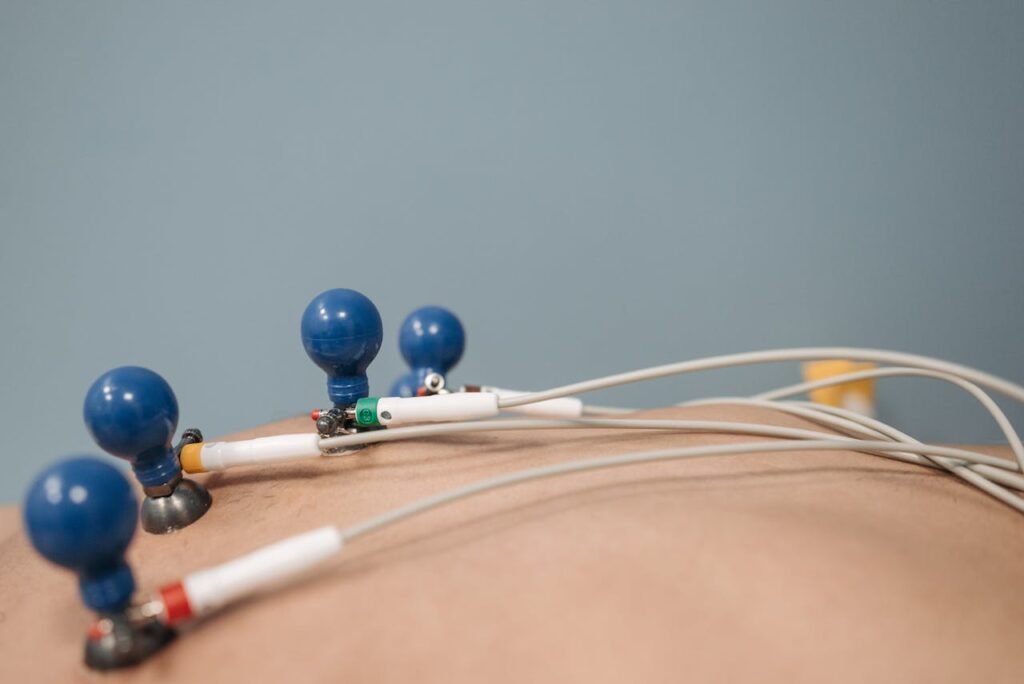Electronic Muscle Stimulation, or EMS, can be a powerful tool for amputees. It helps rebuild strength, reduce pain, and prepare the body for a prosthetic. But like any tool, EMS must be used the right way.
Many people start using EMS with good intentions. They want to heal faster, feel stronger, or manage pain without pills. But without proper guidance, they often make small mistakes that can slow down progress—or even cause discomfort.
This article will walk you through five common mistakes to avoid when using EMS on an amputated limb. Whether you’re new to EMS or have been using it for a while, these tips will help you use it safely, effectively, and confidently.
Let’s begin.
Mistake 1: Placing the Electrodes Incorrectly
Why Electrode Placement Matters

The placement of EMS pads is one of the most important parts of therapy. If the pads are not placed on the correct muscles, the stimulation won’t reach the right area. That means your muscles won’t get the full benefit.
For amputees, this becomes even more sensitive. The residual limb has changed shape. The nerves are healing. And certain areas may still be tender or swollen.
Putting the pads too close to the wound, or on bones or joints, can cause pain instead of relief.
Common Placement Errors
One of the biggest mistakes we see is placing the electrodes randomly—wherever there’s space. But muscles aren’t evenly spread across the limb. Placing pads on the wrong part won’t activate the muscles you want to target.
Another issue is placing the pads too far apart. This weakens the effect of the current and reduces the quality of the contraction.
And sometimes, people place them too close together, which causes sharp tingling or skin irritation.
What You Should Do Instead
Always follow a plan approved by your physiotherapist. If you’re using a device like BrawnBand, follow the diagrams we provide. These are based on actual muscle maps for different types of amputations.
If you’re not sure, send a photo to your therapist or our support team. It’s better to double-check than to guess.
Proper placement gives you stronger contractions, better results, and less chance of discomfort.
Mistake 2: Using the Wrong Intensity Level
More Is Not Always Better
Many users think that turning the intensity up will help muscles get stronger faster. But this is a common misconception.
High intensity does not mean high benefit. In fact, too much stimulation can lead to muscle fatigue, soreness, or even cramps.
Your muscle may contract more forcefully, but that doesn’t always lead to better healing. It can cause strain, especially if your limb is still recovering from surgery or trauma.
When High Intensity Becomes a Risk
If you feel a burning sensation, skin discomfort, or sharp twitches during EMS, your intensity is likely too high.
This can irritate the nerves and even increase phantom pain in some cases. It can also damage skin if used repeatedly at high levels in the same spot.
This is especially true for new users, or for people with sensitive skin or reduced blood flow.
The Safer and Smarter Approach
Start slow. Begin with a low to medium setting and observe how your body reacts. You should feel a strong but comfortable contraction—not pain, not shock.
Over time, as your muscles strengthen and your nerves adjust, you can increase intensity gradually. But always with care.
A good EMS session feels like effort, not struggle. That’s how you know it’s working the right way.
Mistake 3: Using EMS Too Soon After Surgery
Healing First, Stimulation Later
Right after amputation, your body is going through a lot. The wound is fresh. The skin is sensitive. The nerves are in shock. This is not the time to start EMS.
But many users think starting EMS immediately will speed up healing. The opposite is true. Starting too soon can interfere with healing and cause new problems.
EMS should never be used on open wounds or swollen areas unless a doctor clearly says it’s safe.
Risks of Early EMS Use
If you start EMS before the wound has closed fully, you risk irritating the tissue. The electrical pulses can delay healing, increase infection risk, or cause unnecessary pain.
Even if the skin looks okay from the outside, the inside tissues may still be fragile. Too much stimulation can lead to bleeding, bruising, or inflammation.
And using EMS too early may confuse your body’s natural recovery process, causing poor coordination later on.
The Right Time to Begin
Your surgeon or therapist will tell you when to begin EMS. This is usually after the wound has healed and the stitches are gone.
You’ll start with gentle sessions, low intensity, and short durations. This helps your body get used to the sensation and build tolerance.
Slow, safe beginnings lead to faster long-term results.
Always ask before starting. If you’re unsure, wait and get advice first.
Mistake 4: Skipping Daily Skin and Pad Checks
Your Skin Needs Extra Care

The skin around an amputated limb is often more delicate than the rest of your body. It may have scar tissue, thinner layers, or reduced circulation.
That means it can get irritated faster—especially with daily EMS use. Sweat, heat, or even friction from the pads can cause redness or itching if not managed.
Ignoring your skin health is one of the easiest ways to turn a good EMS routine into a painful one.
Pads That Are Too Old or Dirty
Another common issue is reusing the same electrodes for weeks without cleaning or replacing them.
Old pads lose their stickiness. They don’t conduct the current well. That causes uneven stimulation, skin discomfort, or even small shocks.
Dirty pads also trap bacteria, increasing the risk of infection—especially if your skin is already sensitive.
The Right Way to Protect Your Skin
Before every session, inspect your skin. Look for redness, cuts, or dry patches. After every session, clean the area with a soft cloth and let it breathe.
Change your pads regularly. Clean them as directed, and store them properly between uses.
If you feel unusual itching, burning, or see marks that don’t fade—pause your EMS and contact a professional.
Healthy skin means longer-lasting therapy and fewer problems down the road.
Mistake 5: Using EMS Without a Rehab Plan
EMS Is a Tool, Not a Shortcut
Some users treat EMS like a magic fix. They turn it on once or twice, expect quick results, and then stop when they don’t feel a big change.
But EMS is not magic. It’s a tool—one part of a bigger recovery plan. On its own, it won’t rebuild your strength or improve movement unless you use it correctly and consistently.
Using EMS without knowing what you’re trying to achieve leads to frustration and wasted time.
No Routine, No Results
Random EMS sessions won’t help. You need a schedule—a clear, realistic plan that fits your stage of recovery.
This includes when to use it, how often, what intensity, and what your long-term goals are.
Without a plan, you might overuse it, skip key sessions, or miss out on combining it with physical movement or prosthetic training.
Work With Experts, Stay On Track
The best EMS results happen when it’s part of a larger rehab journey. Work with your physiotherapist to build a routine that grows with you.
As your strength builds, the plan can be updated. Your goals may shift from pain relief to muscle building to movement coordination.
And if you’re using a device like BrawnBand, our team can guide you through every stage—so you always know what comes next.
Why Avoiding These Mistakes Matters So Much
Amputee Recovery Is Not Trial and Error

For someone who’s lost a limb, every part of the rehab journey counts. Each step forward brings hope—and every setback can bring frustration or fear.
Using EMS the wrong way isn’t just a technical issue. It can affect motivation, delay recovery, and even make the body less responsive to future therapy.
That’s why these mistakes are more than just common errors. They can slow progress, increase pain, or create a lack of trust in the recovery process.
And that’s something we must avoid.
EMS Is a Long-Term Companion
EMS isn’t something you use for a week and forget about. It becomes part of your daily or weekly routine—sometimes for months, sometimes even years, depending on your needs.
So learning how to use it properly from the beginning sets you up for long-term success.
If you build good habits early—safe placement, proper intensity, clean skin, regular use—your body responds better. You feel stronger, move with more control, and build a foundation that helps you live more independently.
That’s why the small things matter.
For Clinics, It Builds Trust and Results
If you run a rehab center or prosthetic clinic, your patients look to you for more than services. They want clear advice. They want results. And most of all, they want to feel cared for.
When you help them avoid these EMS mistakes, you’re doing more than delivering therapy. You’re protecting their recovery journey.
This improves their outcomes, their satisfaction, and their word-of-mouth.
It also sets you apart from clinics that hand over a machine without much guidance.
When you offer EMS as part of a well-structured care plan—especially one designed for daily or home-based use—you become more than a clinic. You become a trusted partner.
Turning Mistakes Into Best Practices
Train Patients From Day One

Don’t assume your patients know how to use EMS—even if they say they’ve done it before.
During the first session, walk them through pad placement, session timing, and what sensations are normal. Let them feel confident. Answer their questions, even the basic ones.
This first impression makes a huge difference in how likely they are to use EMS consistently—and use it safely.
Create Simple EMS Routines
Patients don’t need complex rehab schedules. They need something they can actually follow.
Create a weekly calendar they can stick on the wall. Use simple language: “Morning – 15 mins EMS, Mode 1” or “Evening – EMS + 5 mins movement.”
Avoid medical jargon. Focus on clarity, comfort, and consistency.
You can even check in weekly to update their plan based on how their body is responding.
Encourage Feedback and Adjustments
Many patients are afraid to speak up if something doesn’t feel right. They think it’s normal to feel discomfort or numbness, or they worry they’ll sound like they’re complaining.
Create a space where they can share what they’re feeling. Ask open questions: “How did your body feel after yesterday’s session?” or “Was there any part that felt uncomfortable?”
This helps you catch mistakes early and gives you a chance to improve their routine.
And when they feel heard, they’re more likely to stay engaged.
The Role of Technology in Preventing EMS Mistakes
Smarter Devices Make Safer Rehab
In the past, EMS devices were bulky, complex, and often required a technician to operate. Today, technology has made things simpler—but not all devices are equally smart.
Modern EMS systems like BrawnBand are built with safety features that protect against common errors.
If pads are not placed correctly, the device may alert you. If intensity is too high, it allows you to adjust it in real-time. It even stores session data so your therapist can see how you’re progressing.
These smart features reduce the risk of misuse—especially for first-time users or elderly patients.
When a device can think with you, it becomes a safer and more effective partner in recovery.
Digital Tracking for Therapists and Clinics
For physiotherapists and prosthetic centers, digital tracking offers big advantages.
When your patient uses an EMS device at home, you can monitor their usage patterns remotely. You can see if they skipped a session or used too much intensity.
This feedback helps you guide their rehab better and catch problems before they become serious.
Some platforms allow you to update therapy plans online or send reminders to the patient through an app. This turns your care into a daily presence—even from a distance.
And for businesses, it means better service quality, stronger patient loyalty, and better outcomes.
Building a Community Around EMS Education
Peer Support Helps Patients Learn Better

Many amputees feel isolated during recovery. They don’t know what’s normal, what’s dangerous, or whether they’re doing things right.
When clinics or support groups create safe spaces—online or offline—where patients can share their EMS experience, it speeds up learning.
Someone who’s already overcome these mistakes can guide someone who’s just starting out.
This sense of belonging increases motivation. It helps patients stick with their plan. And it builds confidence in the journey.
You can organize monthly EMS workshops, WhatsApp groups, or simple Q&A sessions led by a rehab specialist. These don’t have to be formal. They just have to be human.
Partnering With Prosthetic Companies and NGOs
If you’re running a clinic or local rehab center, you don’t have to do everything alone.
Collaborate with companies like Robobionics, who provide not just EMS tools like BrawnBand, but also patient support, training materials, and field-tested rehab guides.
Partnering with NGOs or government health schemes can also bring EMS to people who can’t afford traditional rehab.
Together, you can prevent the common EMS mistakes we’ve discussed—and expand access to life-changing therapy across India.
How Preventing EMS Mistakes Improves Prosthetic Fit and Function
Stronger Muscles, Better Socket Fit
One of the most overlooked aspects of prosthetic success is the condition of the residual limb. If the muscles are weak or the shape of the limb changes too much, the socket won’t fit well.
This can lead to pain, instability, or even refusal to wear the prosthetic.
Daily EMS, when done correctly, helps maintain the shape and tone of the residual limb. The muscles stay firm, the skin stays healthy, and the limb retains the volume needed for a snug prosthetic fit.
Avoiding the mistakes we’ve covered ensures this benefit lasts over time—making prosthetic training smoother and more effective.
Faster Adaptation to Myoelectric Devices
For those preparing to use advanced prosthetics like Grippy™—which respond to myoelectric signals—daily EMS plays an even bigger role.
Myoelectric hands work by picking up signals from the muscles in the residual limb. If those muscles are inactive or under-stimulated, the signals are weak and the control is poor.
Regular EMS strengthens these muscles and improves signal clarity. But only if the pads are placed correctly, the intensity is right, and the skin remains healthy.
Using EMS the wrong way can do the opposite—causing uneven signals or even leading to poor grip response.
So, for users planning to transition into bionic hands or fingers, mastering EMS early is not just helpful—it’s essential.
Making EMS More Accessible Across India
Serving Tier-2 and Tier-3 Cities

In smaller cities and rural areas, advanced physiotherapy services are often missing. Clinics may not have the staff, time, or technology to offer complete rehab.
This is where at-home EMS becomes a game-changer.
With proper education and the right device, patients can carry out most of their rehab independently at home. But again, only if they avoid the mistakes we’ve discussed.
This makes EMS not just a therapy—but a bridge that connects patients in remote areas to world-class recovery.
And for businesses, it creates an opportunity to scale care in places where there is need but no infrastructure.
Training Local Therapists and Caregivers
Another way to reduce EMS misuse is to empower local health workers. By training physiotherapists, nurses, and even family caregivers on how to safely guide EMS use, the support system becomes stronger.
Short workshops, demo kits, and multilingual instructions can help build EMS literacy at the grassroots level.
The more people understand what not to do with EMS, the more confident and successful the users become.
This shared knowledge prevents harm, increases trust, and leads to better overall outcomes.
Final Thoughts: Small Changes, Big Impact
Avoiding EMS mistakes isn’t about doing things perfectly. It’s about being aware, asking questions, and learning what works best for your body.
Whether you’re an amputee using EMS at home, a caregiver helping a loved one, or a clinic guiding dozens of patients—these small corrections can make a big difference.
Correct pad placement, gentle intensity, clean skin, patience, and a solid rehab plan—these are the building blocks of successful EMS therapy.
And the good news? Every mistake is fixable. Every day is a new chance to improve.
At Robobionics, we’ve worked with hundreds of amputees and clinics across India. We’ve seen what EMS can do when it’s used right. We’ve also seen how the smallest mistake can delay progress.
That’s why we built BrawnBand—to make EMS easy, safe, and effective for Indian homes and clinics. But more importantly, we built it to empower you.
Because we believe rehab should be clear, kind, and within reach. And you deserve tools that meet you where you are.
So if you’re ready to start EMS therapy—or improve how you’re using it—let’s talk.
Book your free BrawnBand demo today at https://www.robobionics.in/bookdemo
We’ll guide you, step by step. No pressure. No confusion. Just real support, designed for your journey.
Because healing isn’t just about doing more. It’s about doing it right.
And we’re here to help you every step of the way.



